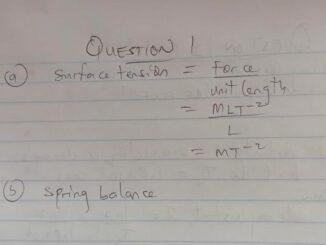Welcome to “Naijaclass Academy” For Waec Marketing 2024 May/June Exam Answer

Date: Thursday, 6th June 2024
Marketing (Essay & Objective) 2:00 pm – 4:50 pm
——————————
MARKETING OBJ
01-10: CADDCCCCBB
11-20: ACBBBCDCDA
21-30: BDCADDBACB
31-40: CCADBBBCAD
======================================
WAEC 2024 MARKETING ESSAY ANSWERS
ANSWER FOUR (4) QUESTIONS ONLY
====================================
(NUMBER 1)
(1a)
(i) Needs: Needs are fundamental necessities that individuals must have to live and function. Examples include food, water, shelter, clothing, and healthcare.
(ii) Wants: Wants are the specific forms of needs that are shaped by culture, society, and individual personality.
(1b)
(PICK ANY FOUR)
(i) Marketing helps a company in carrying out marketing research to gather, analyze, and interpret information about the market, consumers, and competitors.
(ii) It is involved in product planning and development, which includes designing, creating, and managing products to meet customer needs and preferences.
(iii) Marketing is responsible for selling the company’s products
(iv) Marketing determines the price of products, balancing profitability with customer satisfaction.
(v) Marketing determines the channels of distribution to ensure that products are available to consumers at the right place and time.
(vi) Marketing engages in advertising and other promotional activities.
(1c)
(i) Product concept: This is an orientation that assumes that the customer will favour products that are of high quality.
(ii) Selling concept: The selling concept is based on the assumption that even when products are of high quality, available and affordable, consumers would still not buy unless they are persuaded to buy.
(iii) Production concept: This concept assumes that consumers would buy products that are available and at lower prices, thus companies concern themselves with mass production.
(iv) Marketing concept: This concept centers on meeting the needs and wants of target markets more effectively than competitors.
:::::::::::::::::::::::::::::::::::::::::::::::::::::::::::::::
(NUMBER 2)
(2a)
(PICK ANY ONE)
Consumer products are goods and services that are intended for personal or household use, such as food, clothing, electronics, and appliances.
OR
Consumer products are products that are purchased by individuals or households for personal use.
(2b)
(PICK ANY THREE)
(i) Road Transportation: This involves the use of trucks, vans, or other vehicles to transport goods by road. It is flexible and suitable for short to medium distances, offering door-to-door delivery options.
(ii) Rail Transportation: This utilizes trains to move goods over long distances, both domestically and internationally. It is particularly suitable for transporting bulk goods such as coal, grain, and minerals.
(iii) Air Transportation: This involves the use of airplanes to move goods quickly over long distances. It is ideal for transporting time-sensitive or high-value goods, as well as perishable items.
(iv) Sea Transportation: This utilizes ships and vessels to transport goods over oceans and large bodies of water. It is well-suited for transporting bulky or heavy goods in large quantities.
(v) Pipeline Transportation: Pipeline transport involves the use of pipelines to transport liquids, gases, or other materials over long distances.
(2c)
(PICK ANY THREE)
(i) Capital goods: These are used in production, such as manufacturing equipment or vehicles.
(ii) Raw materials: These are unprocessed materials used in production, like lumber or metals.
(iii) Component parts: These are used to manufacture finished products, like engines or electronics.
(iv) Supplies and services: These are necessary for day-to-day operations, like office supplies or maintenance services.
:::::::::::::::::::::::::::::::::::::::::::::::::::::::::::::::
(NUMBER 3)
(3a)
(PICK ANY EIGHT)
(i) Discounts
(ii) Coupons
(iii) Contests
(iv) Free Samples
(v)Buy One, Get One (BOGO) Offers
(vi) Loyalty Programs
(vii) Bundle Deals
(viii) Flash Sales
(ix) Product Demonstrations
(x) Referral Programs
(xi) Patronage awards
(xii) Salesmen competition
(3b)
(PICK ANY SIX)
(i) Sales promotional tools can stimulate demand and lead to an increase in sales revenue.
(ii) Promotions can attract new customers who may be enticed by the special offers.
(iii) Promotional tools can help retain existing customers by offering incentives for repeat purchases.
(iv) Promotions can raise awareness of the brand and its products among consumers.
(v) Using promotions effectively can differentiate the company from competitors and attract customers.
(vi) Promotions can help clear excess inventory or slow-moving products, freeing up space and capital.
(vii) Promotions can provide an opportunity to gather feedback from customers, helping the company understand their preferences and needs.
(viii) Effective use of promotions can foster loyalty among customers who appreciate the value and savings offered.
:::::::::::::::::::::::::::::::::::::::::::::::::::::::::::::::
(NUMBER 4)
(4a)
(PICK ANY FOUR)
(i) The association would help regulate and stabilize the prices of yams to ensure fair pricing for both sellers and buyers.
(ii) The association can negotiate better prices from suppliers, reducing costs for individual members who are buying yam in bulk.
(iii) The association would gather and share important market information, such as demand trends, price changes, and new market opportunities.
(iv) The association can represent the interests of yam sellers in discussions with local authorities and policymakers, advocating for better market conditions and policies that benefit members.
(v) They will provide members with quality training sessions and workshops on best practices in yam storage, handling, and marketing.
(vi) The association will establish a cooperative credit facility to provide members with access to loans or credit, helping them to invest in their businesses and manage cash flow.
(vii) The association would mediate disputes among members or between members and customers, ensuring a harmonious and cooperative business environment.
(4b)
(PICK ANY FOUR)
(i) Transport Companies: They help yam sellers by transporting their goods from farms to the market efficiently and safely, reducing the risk of spoilage and ensuring timely delivery.
(ii) Storage Facilities: They offer proper storage solutions to prevent spoilage and extend the shelf life of yams, ensuring that sellers can store excess stock and sell it when prices are favorable.
(iii) Financial Institutions: They offer loans, credit, and other financial products that help yam sellers manage their cash flow, invest in their businesses, and expand their operations.
(iv) Advertising Agencies: They help yam sellers create advertisements and marketing campaigns to attract more customers, increase sales, and build brand recognition.
(v) Market Research Firms: These firms provides valuable insights into consumer behavior, market trends, and competitive analysis, helping yam sellers make informed business decisions and strategies.
(vi) Packaging Companies: They help yam sellers with attractive and functional packaging that protects the yams during transport and storage, and enhances the appeal of the product to customers.
(vii) Legal Advisors: They help the association and its members with legal matters, such as drafting contracts, resolving disputes, and ensuring compliance with local regulations.
:::::::::::::::::::::::::::::::::::::::::::::::::::::::::::::::
(NUMBER 5)
(5a)
(PICK ANY FOUR)
(i) Personal Savings: This is the money that Adamu has saved over time from his personal income. It does not involve any debt or repayment.
(ii) Bank Loans: Adamu can approach banks to obtain loans which can be repaid over a fixed period with interest.
(iii) Venture Capital: Venture capitalists are investors who provide capital to startups with high growth potential in exchange for equity.
(iv) Family and Friends: Adamu can seek financial assistance from family members and friends who believe in his business idea. This source of funding can be more flexible and have more favorable terms than traditional loans.
(v) Government Grants: Adamu might be eligible for government grants aimed at supporting small businesses. These funds do not need to be repaid, but they often come with specific requirements or conditions.
(5b)
(PICK ANY FOUR)
(i) Nearness to market: The location should be easily accessible to Adamu’s target market.
(ii) Cost of rent and utilities should be considered to ensure the business remains profitable.
(iii) Adamu needs to consider the presence of competitors in the area.
(iv) Proximity to Suppliers should be considered because being close to suppliers can reduce transportation costs and ensure a steady supply of products.
(v) The safety and security of the location are important for protecting inventory and ensuring the safety of customers and employees. A secure location can also reduce insurance costs.
(vi) The availability of adequate infrastructure such as good roads, reliable power supply, water, and internet connectivity can influence the operational efficiency of the business.
(vii) Availability of support services such as banking and telecommunication.
(viii) Government policy: Adamu would consider government regulations and policies with regard to the establishment and operations of te store.
:::::::::::::::::::::::::::::::::::::::::::::::::::::::::::::::
(NUMBER 6)
(6a)
(i) Demand: The quantity of OJ Ltd’s products that consumers are willing and able to purchase at a given price level.
(ii) Products: The goods manufactured by OJ Ltd, such as consumer goods, that meet the needs and wants of target customers.
(iii) Market: The group of consumers and organizations that OJ Ltd aims to serve, including retail outlets and end-users.
(6b)
(PICK ANY TWO)
(i) Wholesalers
(ii) Retailers
(iii) Distributors
(iv) Direct Sales
(6ci)
(PICK ANY THREE)
(i) Buying and storing products in bulk
(ii) Breaking bulk and selling to retailers
(iii) Providing market information to manufacturers
(iv) Offering credit facilities to retailers
(v) Managing logistics and transportation
(6cii)
(PICK ANY THREE)
(i) Buying products from wholesalers or manufacturers
(ii) Displaying and promoting products to customers
(iii) Providing customer service and support
(iv) Managing inventory and stock control
(v) Processing transactions and sales data





Can’t we just see the questions before exam? Even without answer
Yes
Pls the pin
Please I need the marketing questions and answers today
Please i need it today
Number 10 question marketing
2024
Lovely I am really interested
Good evening pls i need to pass my exams
Please i need help
Go try exam plaza
I need marketing pin pls
Please sir help us
Please sir help us
I need marketing pin please
Nice one
Pls pin sir
thank you very much